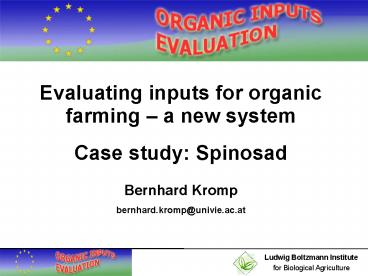Folie 1 - PowerPoint PPT Presentation
1 / 14
Title: Folie 1
1
Evaluating inputs for organic farming a new
system Case study Spinosad Bernhard
Kromp bernhard.kromp_at_univie.ac.at
2
Contents
- The spinosad working group
- Brief specifications of spinosad
- The testrun process applicant vs. evaluators
agreements differences - Conclusions of the evaluation testrun
- key issues in favour or causing concern
- Experiences from using the matrix
- Final (preliminary) recommendation open
questions
3
The Working Group Spinosad
- Why spinosad?
- PPP of microbial origin (bio-pesticide)
- Widely used in conventional farming
- Allowed already for OF in a few countries
- Composition and roles of the WG
- 1 applicant, 2 MS evaluators, 2 external
experts, 1 EU panel expert - Mode of action
- Earlier testruns -gt installment of the WG -gt
application -gt MS evaluation external
experts comments -gt compilation final
evaluation key issues recommendation
4
Spinosad brief specifications 1
- Name Spinosad
- Origin fermentation product of the actinomycete
soil bacterium Saccharopolyspora spinosa - Active ingredient spinosyns ( bacterial toxins)
- Manufacturing process for economically feasible
industrial fermentation, chemical mutants of S.
spinosa are used aerobic fermentation process in
aqueous growth media (containing e.g. corn
solids, soja bean flour, cottonseed flavour)
extraction recrystallization of techn. spinosad - Composition mixture of spinosyn A and spinosyn D
- (85 15), up to 10 residues from fermentation
broth
5
Spinosad brief specifications 2
- Mode of action
- Toxic on nervous system of insects
- Use
- insecticide against caterpillars, leaf miners,
thrips etc. in various fruit vegetables, field
crops, fruits, ornamental plants etc. - Necessity in OF examples
- against thrips in leaks (no alternatives)
- sucking insects on bell peppers
- apple codling moth (alternatively to granulose
virus) - leaf-mining diptera (no alternatives available)
6
Spinosad brief specifications 3
- Approval in EU currently approved in
conventional farming under 91/414/EC in 14 EU and
many (gt 50) non-EU countries (e.g. Tracer,
Success, Conserve, Spintor,...) - Organic farming standards allowed for OF in CH,
US, Argentina fulfils inclusion criteria
(...microbial origin...) of IFOAM Basic
Standards and Codex Alimentarius - Application spraying above ground on all plant
parts (depends on crops)
7
Applicant versus Evaluator 1 agreement in
scorings of use necessity and human health
8
Applicant versus Evaluator 2 different
scorings in environmental impacts
9
Side-effects are acknowledged...
10
..and avoided by proper instructions SAFETY
PRECAUTIONS
- Environmental protection
- To protect aquatic organisms respect a buffer
zone refer to section on LERAP for buffer zone
width to surface water bodies. - DO NOT ALLOW DIRECT SPRAY from broadcast
air-assisted sprayers to fall within 40 metres of
the top of the bank of a static or flowing
waterbody, unless a Local Environmental Risk
Assessment for Pesticides (LERAP) permits a
narrower buffer zone, or within 5 metres of the
top of a ditch which is dry at the time of
application. Aim spray away from water. - DO NOT ALLOW DIRECT SPRAY from horizontal boom
sprayers to fall within 5 metres of the top of
the bank of a static or flowing water body, or
within 1 metre of the top of a ditch which is dry
at the time of application. Aim spray away from
water. - This product qualifies for inclusion within the
Local Environmental Risk Assessment for
Pesticides (LERAP) scheme. Before each spraying
operation from a horizontal boom sprayer or
broadcast air-assisted sprayer, either a LERAP
must be carried out in accordance with PSDs
published guidance or the statutory buffer zone
must be maintained. The results of the LERAP must
be recorded and kept available for three years. - DO NOT CONTAMINATE WATER with the product or its
container.
11
Conclusions
- Key issues in favour
- origin is compliable with OF standards
- economically necessary for certain high value
crops - Key issues causing concern
- some environmental side-effects
- public perception of spinosad as a conventional
PPP
12
Experiences using the matrix for spinosad
- Difficult to score
- when few or contradictory information is
available (e.g. for some of the environmental
impacts) - when only soft facts are available, especially
in public perception (e.g. question of
conventional PPP, question of possible GMO
residues from fermentation broth)
13
Final (preliminary) recommendation
- Inclusion of spinosad in Annex II B with
restriction - Proposed restriction Need recognized by the
- inspection body or inspection authority
14
Open questions to the audience
- How should the scoring distinguish between
environmental/health hazards (potential risk) and
the actual risks (taking into account
restrictions on use)? - How to define additional restrictions in OF in
Annex II (e.g. for certain crops)?































